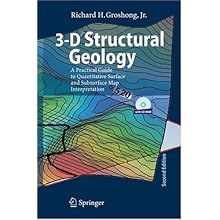* Publisher: Springer
* Number Of Pages: 400
* Publication Date: 2008-07-01
* ISBN-10 / ASIN: 3540310541
* ISBN-13 / EAN: 9783540310549
Product Description:
This is a handbook of practical techniques for making the best possible interpretation of geological structures at the map scale and for extracting the maximum amount of information from surface and subsurface maps. The 3-D structure is defined by internally consistent structure contour maps and cross sections of all horizons and faults. The book is directed toward the professional user who is concerned about both the accuracy of an interpretation and the speed with which it can be obtained from incomplete data. Quantitative methods are emphasized throughout, and numerous analytical solutions are given that can be easily implemented with a pocket calculator or a spreadsheet. Interpretation strategies are defined for GIS or CAD users, yet are simple enough to be done by hand. The user of this book will be able to produce better geological maps and cross sections, judge the quality of existing maps, and locate and fix mapping errors.
The second edition has been reorganized to more nearly follow the typical interpretation workflow. A significant amount of new material has been added, in particular numerous examples of 3-D models and techniques for using kinematic models to predict fault and ramp-anticline geometry. The new edition includes a CD which supplements the text in several ways. Text figures are reproduced in color and complete Tecplot models are provided for a number of representative figures. For those interested in working exercises in mapping software, xyz input files are provided in text format for many of the map-based exercises. Answers to selected exercises are included.
This is probably the best available text on three-dimensional representation of geological structures. It is a handbook for use by professionals but would also serve as a supplemental text for structural geology or workstation courses.
The content is logically organized, well focused, clearly written and complete. The topics begin with the basics. These include classification, description and analysis of structures. More advanced topics follow. They range from dynamic interaction between structural and sedimentary events to fluid movements and to restoration. The worked examples are simple and clearly make their respective points. The exercises range from rudimentary to somewhat challenging for the first-time student of structural geology. Many topics would be new to anyone who has not kept current with advances in structural geology. These include, among others, new techniques in dip sequence analysis and calculating area-depth relations.
Modern technology in the form of workstations permits geoscientists to produce spectacular graphics depicting geological structures and their development. A common complaint of energy company managers is that the interpretive graphics look so good that they are believable simply because of the presentation. When financial decisions such as drilling are made based on those interpretations they often are found to be incorrect. Workstation interpreters could significantly improve the quality of their structural interpretations if they master the content of Dr. Groshong's book. Moreover, as visualization becomes an important trend to the future of interpretation technology, the basic science represented by this book takes on a more important and timely meaning.
The price of the book may seem to be excessive. This is especially evident when compared with texts prepared by non-profit organizations such as the American Association of Petroleum Geologists. Those books are more attractive because they use color and are printed on better quality paper. This book has no color and is printed on ordinary quality paper. However, if the price of the book is compared with similar books published by for-profit book houses, the price is competitive. In the final analysis, the content of the text and quality of the writing more than justify its purchase.
I recommend this text to all interested in the study and practice of structural geology, especially interpreters using workstation or visualization technology.






Tidak ada komentar:
Posting Komentar